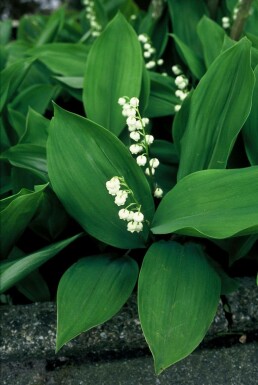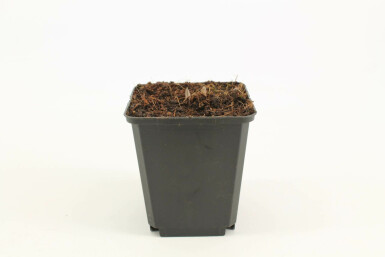

20cm



Updated on 10 September 2025
We regret to inform you that we are currently unable to ship orders to the United Kingdom. We anticipate being able to resume shipments at the beginning of 2026.
Convallaria thrives in shaded gardens, offering fragrant blooms and excellent ground cover. This hardy plant spreads well, is low maintenance, and attracts bees, enriching the garden's ecosystem with its white, bell-shaped flowers. Perfect for natural underplanting and shaded borders.


20cm



Convallaria is a charming plant that thrives in shaded gardens. With its oval leaves emerging from rhizomes, it produces white, bell-shaped flowers in spring, offering an intense scent. As a ground cover, Convallaria is perfect for creating a natural look beneath trees or in woodland areas. These fragrant blooms add beauty and aroma, making any garden feel alive. Furthermore, this plant’s red berries add a touch of colour after the blooming season. Curious about how to fill those shady spots in your garden with beauty and scent? Convallaria may be just what’s needed. Consider exploring options to buy Convallaria pips in the UK to enhance your shaded areas with these delightful lily-of-the-valley scents.
Convallaria, also known as lily of the valley, is a beautiful perennial plant belonging to the Asparagaceae family. This fragrant groundcover is often found in shaded areas of the garden. It thrives in cool, damp soil conditions and is particularly popular in woodland-like settings. The plant is also known as Woodland lily and Scented groundcover. Lily of the valley is commonly used for underplanting, shaded borders, or along forest edges. In natural gardens, it serves as an attractive foliage backdrop and also functions as an insect nook by attracting hoverflies and bees. However, it is important to note its poisonous properties, which deter grazing animals. Geographically, Convallaria can be found across Europe, Asia, and North America, primarily in deciduous forests. Despite its wide distribution, it is admired and cultivated in gardens worldwide. The plant has a significant role in its natural habitat, being one of the early spring flowers. The name "lily of the valley" comes from Latin and is a symbol of purity, love, and humility, often linked with the Virgin Mary. Its lifecycle as a perennial allows it to return each year, slowly spreading via rhizomes. Many enthusiasts choose to buy Convallaria pips to introduce this shade-loving and fragrant plant into their garden spaces.
The Convallaria, known for its delicate beauty, thrives in shaded areas. It is a perennial groundcover, forming slowly through rhizomes. The plant produces oval leaves that emerge from the rhizomes, creating a lush, green carpet. These leaves provide the perfect backdrop for the white, bell-shaped flowers that appear in spring. The flowers are renowned for their intense lily-of-the-valley scent, making this plant a popular choice for shaded borders and forest edges. The Convallaria's growth is steady, with foliage timing playing a crucial role. It typically begins sprouting in early spring and reaches its mature height between 15 cm and 30 cm. This growth depends on factors such as soil condition, with damp soil needs being essential for optimal development. The bloom period is usually in April and May, influenced by climate and temperature. The flowers of the Convallaria are predominantly white, though occasionally they can be pink. Soil quality, light conditions, and climate can affect the colour intensity. After blooming, the plant produces red berries, adding to its visual allure. Convallaria, or lily of the valley, is not only visually appealing but also has poisonous properties, adding an extra layer of interest. Its fragrance is a key feature, attracting insects and adding to garden biodiversity. The Convallaria is a charming garden plant with fragrant bell-shaped flowers. Whether used as a groundcover or an underplanting, it enhances any natural garden setting.
Convallaria has distinctive lanceolate and oval leaves that arch upright. The leaves are fresh to dark green, providing a striking appearance in the garden. These leaves play an important role in plant adaptation, dying back to store energy underground and promoting swift spreading through its rhizomes. The plant is very hardy, surviving temperatures as low as -40°C to -29°C, and thrives in USDA zones 3 to 5. Its preference for shade makes it an ideal choice for woodland areas. Unlike many other plants, Convallaria is not evergreen and loses its leaves in the summer, contributing to its hardiness by conserving energy. This plant is remarkably heat and drought tolerant due to its deep root system and robust leaf structure. Convallaria is highly toxic, especially the berries and leaves, so caution is necessary around children and pets. However, when managed carefully, it remains a safe choice for gardens. Despite its toxicity, Convallaria is beneficial for biodiversity. It blooms from April to May, offering fragrant white bell-shaped flowers that attract bees. This helps to mimic natural habitats and supports garden ecosystems. Its use as a spreading ground cover enhances garden resilience against weeds and makes it a valuable addition for those wondering how to grow Convallaria majalis in the UK.
Convallaria, commonly known as lily of the valley, is a versatile plant that thrives in shaded areas. It is perfect for adding a touch of elegance and fragrance to woodland gardens. This plant is well-suited for several applications in the garden, making it a favourite amongst garden enthusiasts. Convallaria can be used effectively in the following ways:
Convallaria thrives when combined with various plants that enjoy similar shady conditions. These pairings can create a lush garden area with varied textures and colours. Brunnera, with its heart-shaped leaves and blue flowers, provides a lovely contrast to the white blooms of Convallaria. Similarly, Hosta, known for its large, lush leaves, complements Convallaria's delicate structure. Pulmonaria, with its spotted leaves and early spring blooms, works beautifully alongside Convallaria, adding interest to the garden. Meanwhile, Asarum offers an evergreen touch with its unique leaf shapes, enhancing the perennial beauty of the area. Heuchera, with its vibrant leaf hues, adds a pop of colour, making the green foliage of Convallaria stand out. Together, these plants create a harmonious and fragrant garden setting. Convallaria forms a fragrant carpet of lily-of-the-valley among other ground covers. This blend not only provides aesthetic variety but also ensures a continuous display throughout the seasons, making the garden a delightful space to enjoy.
Convallaria thrives in shaded or partially shaded spots. This plant prefers areas away from direct sunlight. The light conditions are important for its growth and to maintain its fragrance as a fragrant groundcover. Wind can affect Convallaria, as strong gusts may damage the delicate leaves. Planting near a fence or using windbreaks can help reduce this risk. For soil, Convallaria best grows in moist, humus-rich soil. It benefits from slightly acidic conditions. Regular fertilisation and ensuring the soil is well-drained will promote healthy growth. Soil moisture is crucial; wind and sun can dry it out, so mulching can retain moisture. Convallaria prefers consistent moisture, and the right soil conditions prevent drying out. The pH level should be slightly acidic. Factors like rainfall and soil type influence this, so testing soil pH can be helpful. This ensures Convallaria gets the best conditions for growth. Consider buying Convallaria pips in the UK to add to shade perennials for scent in the garden.
Plant Convallaria in early spring or autumn. Avoid planting during frost periods. Pot-grown plants can be planted year-round except in frost. For plants with roots, spring and autumn are ideal. Ensure a shady spot with moist, humus-rich soil. Enrich the soil with leaf mould or compost. Avoid dry or sunny locations as they hinder growth. Distance between plants is crucial. Consider plant type, size at planting, growth speed, and number per metre. Check product details on the Heijnen page for the exact number of plants per metre. This ensures optimal spacing for thriving growth. Prepare the ground well for Convallaria. Dig the soil to aerate it, and add Heijnen planting soil for a nutrient boost. Plant the rhizomes just under the surface, ensuring roots are well-covered. After planting, provide adequate water and fertilise moderately. Lily of the valley thrives in shade and needs consistent moisture. Regular watering and care help it to bloom beautifully. The Convallaria flower is perfect for creating a fragrant groundcover in a shady garden. Its spring bloom will add charm to any woodland setting.
Convallaria, known for its beautiful white flowers in April and May, is a delightful addition to any garden. As a perennial, this plant requires specific care to thrive throughout the seasons. Its fragrant blooms and green leaves create an attractive groundcover, ideal for shady areas.
Pruning Convallaria involves careful removal of dead leaves, best done with clean secateurs to prevent damage. For feeding, a light application of organic fertiliser in spring is beneficial. Check soil moisture regularly; Convallaria should not dry out. Division is recommended every few years in spring to manage spread, ensuring a healthy, manageable garden presence. This woodland lily thrives in shaded borders, underplanting, and natural gardens, attracting hoverflies and bees while being toxic to grazers. For those looking to enhance their garden's beauty, consider buying lily of the valley.
Convallaria stands out for its beautiful white, bell-shaped flowers. These flowers bloom in spring and give off a lovely fragrance, making them a perfect addition to any garden. The fresh green leaves of Convallaria create a striking contrast to the blossoms, adding visual interest even when the plant is not in bloom. Convallaria is known for being bee-friendly. Its sweet scent attracts pollinators, which is great for a healthy garden ecosystem. The plant serves as a strong ground cover, ideal for shady areas where other plants may struggle. Its leaves remain lush throughout the season, providing a green carpet under trees and shrubs. In autumn, the foliage turns darker, offering a subtle change in the garden. Convallaria has a lovely fragrance in spring as a graceful border plant. Its ability to spread slowly via rhizomes means it requires little maintenance, making it a favourite for those looking for low-maintenance greenery. Its role as a fragrant groundcover makes it popular in woodland gardens.
Convallaria, commonly known as lily of the valley, is a popular plant often chosen for shaded gardens in the UK. This fragrant groundcover thrives in damp soil and provides beautiful blooms during April and May. With its poisonous properties, it is important to handle with care. The foliage dies back in summer, but it spreads effectively, making it an excellent choice for those looking to create a lush, green area in shaded parts of the garden. Here are some well-known types of Convallaria:
Convallaria is a popular choice for many gardeners due to its ability to flourish in shaded areas. Known for its charming small white blooms, it can bring life to even the dimmest corners of a garden.
Advantages:
Disadvantages:
Proper soil preparation, site selection, and regular care, including timely fertilisation, can reduce the risk of diseases and pests. For the best growth and bloom, ensure that Convallaria receives the care it needs.
Convallaria is renowned for its ability to flower in shade, with fragrant blooms that enhance any garden space. This hardy plant requires minimal care, making it an excellent choice for garden enthusiasts. Additionally, its foliage timing means it dies back in summer, allowing for seasonal garden planning. For those seeking reliable ground cover, buy Convallaria pips in the UK for their garden needs.
To enjoy the benefits of these stunning blooms, order Convallaria (Lily of the Valley) from Heijnen – a wonderfully fragrant ground cover with classic charm and spring bloom.
We would like to provide some tips on how to plant and care for a Convallaria. By following these tips, you can be sure to enjoy your Convallaria for a long time.
Convallaria thrives in shady or partially shaded areas, where the soil is moist and rich in humus. This environment promotes healthy growth and vibrant blooms. It's essential to choose a spot that's sheltered from strong winds, as the plant prefers calm settings. The ideal soil should be slightly acidic with good drainage to support the plant's underground rhizomes. These rhizomes allow the plant to spread quickly, making it an excellent choice for groundcover in shaded gardens. When planted in the right conditions, Convallaria displays better growth, richer blooms, and improved resistance. It's perfect for a woodland garden or as a natural underplanting. Convallaria should be planted in early spring or autumn to ensure optimal growth. Overall, the correct placement is key to the successful cultivation of this charming lily of the valley.
Preparing the ground properly is essential before planting Convallaria. Begin by enriching the soil with organic materials such as compost, which ensures good nutrient availability and water permeability. This is important for healthy growth and helps the lily of the valley thrive in a shaded garden spot. Pot-grown Convallaria can be planted year-round, except during frost periods. If available as a root ball plant, it is best planted in spring or autumn without removing the jute sack surrounding the roots. After planting, water the plants until they are well-rooted to ensure strong establishment. The size of the plant at planting time will determine the number of plants per square metre. Ensure the soil is moist and slightly acidic, as Convallaria prefers these conditions to bloom beautifully in spring.
Fertilising Convallaria, also known as lily of the valley, is crucial for its growth and flowering. This plant thrives when nourished appropriately, boosting its vitality and overall health. Using organic or organo-mineral fertiliser from Heijnen ensures the plant's robust growth and rich bloom. Apply compost or organic fertiliser in early spring, with a light top-up mid-season if the soil is poor. This routine supports healthy foliage and abundant, fragrant flowers. The amount of fertiliser depends on the size of the plant; larger plants need more. Fertilisers require moisture to be absorbed, so water the garden during dry spells post-application to activate nutrients in the soil. This allows the roots to effectively access and utilise these nutrients, maintaining the lily of the valley's lush appearance and vibrant growth throughout the season.
Convallaria benefits from regular pruning to maintain a tidy appearance in the garden. Pruning helps to promote healthy growth by removing dead leaves, which can harbour unnecessary debris. The best time to prune is in autumn or early spring. During this period, use sharp secateurs to cut away dead leaves and old flowers. This helps ensure that the plant remains vigorous. Good tools are essential for clean cuts that do not damage the plant. It's also important to divide the plant in spring if it becomes overcrowded, which can improve its overall growth. Regular maintenance of this scented groundcover keeps it looking its best, enhancing the garden's aesthetic. Always handle Convallaria carefully as it is slightly toxic.
Convallaria prefers moist, humus-rich soil and requires regular watering during the growing season. It needs moisture, particularly in partial shade, to help establish roots. Newly planted Convallaria should be watered regularly to encourage healthy root growth. Once established, it only needs watering during prolonged dry spells. Providing a generous amount of water less often is better than a little water daily. To reduce evaporation, water in the early morning or early evening. Check the soil to ensure Convallaria truly needs water. Excess water should drain away easily, whether in-ground or in a pot. Drip irrigation systems work best once the plant is fully rooted, but initially, watering by hand is necessary. Convallaria has moderate drought tolerance and can survive some dry periods, but it won't grow as vigorously.
Convallaria, known for its delicate white bell-shaped flowers, adds charm and fragrance to any garden. This plant symbolises purity and love, often associated with the Virgin Mary. Its strong ground cover makes it a fantastic choice for shaded areas. However, care must be taken as it is highly toxic, particularly the berries and leaves. Despite its toxicity, Convallaria is bee-friendly and requires low maintenance, thriving well in shaded spots. Incorporating lily of the valley not only enhances beauty but also provides a natural scent to the garden.
Convallaria is perfect for dividing to keep it healthy and vibrant. This process removes old parts and allows new growth, keeping the plant strong. Dividing Convallaria every three to five years helps the plant flourish and prevents overcrowding. The best time for division is the autumn, but early spring also works well. Use a spade to carefully dig up the plant and separate the rhizomes. Remove any old sections and replant the younger parts in the garden. This gives the Convallaria more space and nutrients to thrive. A hand fork and a sharp knife can improve the process, making it easier to handle delicate roots. Regular division ensures a lush display of lily of the valley flowers each year. Gardening enthusiasts find this method invigorating for both the garden and gardener.
Lily of the valley is a delightful choice for any garden. Known for its white bell-shaped flowers, it thrives in shaded areas. This plant is hardy, low maintenance, and spreads effectively, making it ideal as a fragrant ground cover. In spring, it attracts bees with its intense scent. Order Convallaria (lily of the valley) from Heijnen to enjoy its classic charm and beauty.
